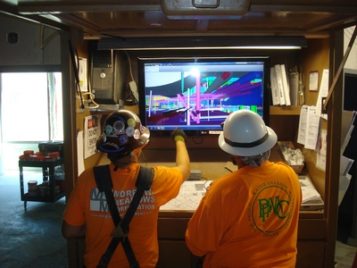By Jeremy Sibert
While electronic planning tables are becoming commonplace, they do not have the means to get everyone on the same page at the same time. The next logical step — already in use in many other industries — is connectivity that can keep project information up to the minute and distribute it teamwide in real-time. That’s where productivity and efficiency really begin to kick in. But that takes a change in attitude and the vision to bring the outside world into a construction zone via a new kind of toolbox.
Consider these scenarios:
- Infection control during construction of a hospital’s capital improvement worries the facility’s officials, until learning the project team’s Wi-Fi setup will help reduce foot traffic through the controlled medical environment of the existing hospital.
- Because of the swiftly evolving technology for cancer treatment, a healthcare system doesn”t purchase an important piece of medical equipment for a new hospital until the very last minute. But there’s no delay in construction because the team checked the status of the buy every day for weeks and the engineer has immediately transmitted the final specs to the onsite crew so it can configure a compatible power source.
- At final sign off on a large facility, inspectors disagree about the interpretation of code. The dispute could delay the opening for weeks. Instead, they step to a computerized booth and look up the regulation. Twenty minutes later, the building is OK”d. None of these things could happen without close communication among all project team members. And that takes more than cell phones, texting and email with drawings attached, an FTP server or a file-sharing service. Building information modeling has advanced the design and construction of buildings in terms of making information portable and 3-D, but it can”t connect people in the way that modern projects need.
A new way to connect
This hybrid tool is called a mobile electronic kiosk. It’s a closet-sized booth that comes equipped with a large screen, computer, BIM software, Wi-Fi capacity and a solar panel to make a self-contained unit that can be moved anywhere on a construction site. It’s narrow enough to fit through any doorway and can be active from the earliest earthwork stages through the final punchlist.
A series of these located in various zones throughout a project can keep an entire crew on task, while giving overseers the capacity to track the project in real time. Owners can access information on everything from personnel and schedule to safety and financials, while everyone onsite — architect, engineer, general contractor and crew, as well as inspectors and other officials —can find the latest drawings with the latest changes, as well as regulations, codes, best practices and recent developments in the field. Each kiosk can be configured to provide open access to the entire project team or provide secure role-based access based on project needs.
Data can be daunting
There’s a huge body of regulations and codes that need to be met for large, complex projects. With a Wi-Fi sign-on to a company’s e-library, an electronic kiosk can help team members solve in minutes what would take an hour or more if they stopped work and walked to the job trailer or site office to check an operations binder.
But the main challenge where data threatens to burgeon out of control is in design changes, which can pile up in a hurry. Recent news about cost overruns at Veterans Administration hospitals highlights how changes can seriously impact schedules. Many states require all owner changes to go through a state health planning department. That can get expensive if crews are idled — or worse, if the work has been completed and needs to be torn out and redone.
Real-time communication
Electronic kiosks offer an alternative. Owners can convene an online meeting with the designer, engineers, the general contractor, tradesmen and inspectors in order to look at the latest BIM together, discuss the changes, adjust as needed and get immediate approvals. Project teams can then post drawings online and attach RFIs and change orders electronically. The latest information is pushed out to everyone — from owners, who can check project progress from their offices instead of the site — down to the least sophisticated subcontractor who comes to the job without a tablet or a smart phone.
In the end, it’s not just technology that helps cut costs and improve schedules. Kiosks are a powerful weapon in the construction arsenal — if allowed to empower the entire team. That takes the right people with the right attitude, not just what’s on the screen.
Jeremy Sibert is director of technology at Hensel Phelps. He has been instrumental in leading the development of electronic kiosks from concept to deployment based upon his knowledge and experience, which includes management of the Pentagon renovation.




 Join our thriving community of 70,000+ superintendents and trade professionals on LinkedIn!
Join our thriving community of 70,000+ superintendents and trade professionals on LinkedIn! Search our job board for your next opportunity, or post an opening within your company.
Search our job board for your next opportunity, or post an opening within your company. Subscribe to our monthly
Construction Superintendent eNewsletter and stay current.
Subscribe to our monthly
Construction Superintendent eNewsletter and stay current.